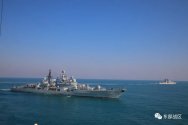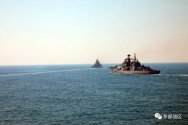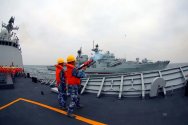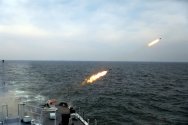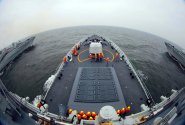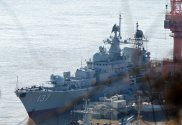If the authors wrote "well beyond" then that's what they meant. No need for gymnastics.
I will summarize and conclude my comparative assessment of the ROC's Kidd and PRC's 956EM air defense capability.
I have provided evidence that the Kidd class destroyers received NTU upgrades, which consisted of the following:
- updating the search radars to 3D S-band SPS-49E and 2D SPS-49 L-band radar. Both radars can detect small fighter aircraft at ranges exceeding 400km
- search radar fusion via AN/SYS-2
- updated fire control system and radars/illuminators to SPG-15D Baseline 15 with auxiliary CWAT X-band antenna
- updated FCR X-band missile uplink to interface with new long range SM-2 missiles for midcourse guidance
- Added S-band missile downlinks via 4 AN/SYR-1 phased arrays to track missile progress to target
- Support for SM-2MR Block III missile with max range of 166km
- Based on a published assessment that the ships can track and illuminate small anti-ship missiles (RCS < 0.5m2) at ranges of at least 77km, by simple inference they can track and illuminate targets with at least 16x higher RCS, such as a Su-27 class target with RCS=10-15m2 at double the range (quadratic root relation: 16^(1/4)=2), i.e. 154km+.
They have 2 dual-arm dual-purpose Mk26 missile launchers, with a published sustained fire-rate of 4 missiles every 9-10s. Each arm of the Mk26 is roughly equivalent in fire-rate to the single-arm Mk13, so the Kidd destroyers had 4 times the fire-rate of the Perry FFGs. However, based on unsubstantiated rumors of a single-arm Mk13 ripple firing SM-2s every 5s, 2xMk26 could optimistically fire 4 missiles every 5s. This is not excessive given that the single arm Uragan launcher could ripple fire missiles at 5s intervals.
On the other hand, the 956EM exported to the PRC has the following AA capability:
- 3D search Fregat MAE radar
- Cross Dome Pozitiv short range search radar for the Kashtan CIWS
- 6x MR-90 Orekh illuminators
- 2x single-arm launchers for 9M317E(?) SAMs with range of 32km-50km depending on which variant was exported.
The newer 9M317 may have inertial midcourse guidance. The original SA-N-7 were home-all-the-way missiles.
Small antiship missiles are likely to have RCS < .3m2, even if BQM-74 has a similar diameter. BQM-74 has straight wings and a vertical rudder while a missile like Exocet or Harpoon has highly swept wings, and X shaped tail with swept fins.
Range of SPS-48E instrumented range is 400km which means this is the range of its longest pulse cycle without incurring ambiguous range. Doesn't mean it detects small fighter aircraft at that range. US brochures never publish information about the RCS size of the target they detect at certain ranges unlike the Russians. Latest SPS-48G has a detect range of 370km (
)
In contrast the Russians don't publish instrumented range but range versus different RCS targets. For example, Fregat has maximum range of 300km, but it doesn't say instrumented range, with 230km for fighter detection. For Russians that means a clean MiG-21 (RCS < 3m2) or MiG-29 (RCS < 5m2) unless specified differently
Information about the range of the Shtil or Buk is detailed enough that 50km has a context that is 95% kill of an F-15 sized target that didn't maneuver.
It doesn't say how far you can engage a bomber sized target, or a range where you can accept a lower probability, say 50% or, if you want to engage a bomber sized target at a 50% PK per missile. A higher PK becomes available if two or more missiles are used. AGAT missile seeker alone has a range of 70km against a 5m2 target.
Orekh can guide up to 2 or 3 missiles with two channels. Does not explain whether that is missile following illuminated target + second missile on midcourse update or two beams, each on a different channel.
Orekh runs on FMCW. Unlike CWAT, which allows for both track and illumination, the use of FMCW allows the radar to range the target. CWI does not range. Because of FMCW, the Front Domes may also be more ECM resistant.
Forgot about the SPG-60 on the Kidd. That adds a third illumination dish on the Kidd, but with lower range. However it does have a higher altitude than the SPG-51 which makes it better for sea skimming targets for longer radar horizon.
Gun radars are also used to search and track sea skimming targets, in this case SPQ-9A and SPG-60 on the Kidd and MR184 on the Sovremenny. The Sov can use both MR123 on the sizes of the ship as well. SPQ-9A covers the front of the Kidd, while SPG-60 covers the back. MR184 covers the front while the two MR123 covers both sides and towards the rear. Pozitiv completes the rear arc for the 956EM but its not present on the 956E.
Now if you want to compare how beefed up the refit is to the original Sov.
Type 382 increases the rate of rotation over the Fregat from 12 rpm to 30, with S-band on one side and C-band on the other. Power is up from 90 kw to 100 kw.
Type 364 has no equivalent on the 956E, but roughly equivalent to the Pozitiv ME on the 956EM. Difference is that the Pozitiv runs on X-band while 364 runs on C-band, Pozitiv has 3D scan but the Type 364 can use pulse compression, which is an issue with frescan arrays (that's probably why they keep SPS-49 parabolic on the Kidd or why the back array on Top Steer uses a parabolic). Type 364 plugs the rear arc on the 956E.
Type 366 radar is similar to the Mineral ME but has better geolocation. It also has added active aircraft detect that goes beyond the radar horizon via atmospheric ducting. The arcs are such that the 366 covers the front of the ship, while the 364 covers the rear.
Type 344 replaces the MR184 in its function, while the Type 349 replaces the MR123.
Orekh illuminators are down to four from six, but the third pair is replaced by a couple of Type 726-3 ECM. The ship also utilizes the ESM units from the 052D.

